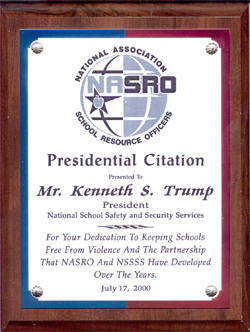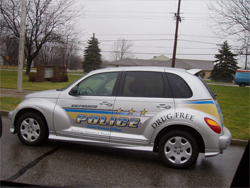2004 National School-Based
Law Enforcement Survey:
School Safety Left Behind?
School Safety Threats Grow as Preparedness Stalls & Funding Decreases
Background
The National Association of School Resource Officers (NASRO) entered into agreement with National School Safety and Security Services for independent professional services for the development, administration, and analysis of NASRO’s fourth annual professional industry survey of school-based police officers. Surveys were independently administered by the staff of National School Safety and Security Services, tallied by Scantron Corporation, and the results analyzed and reported by Kenneth S. Trump, President of National School Safety and Security Services, an independent, non-product affiliated national school safety consulting firm.

The 22-question survey instrument was developed in May of 2004 and administered to attendees of the 14th Annual NASRO Conference held in Phoenix, Arizona, on July 25-30, 2004. 1,100 surveys were distributed to conference attendees upontheir registration. A total of 758 surveys were tallied by Scantron Corporation, representing a return rate of approximately 69%. Whereas every respondent did not answer every question, the total number of respondents for each question will be shown with the chart for each question.
“We cannot continue to cut school safety budgets, the COPS in Schools program, and related funding, and still expect that our children will not be more vulnerable to school violence and a potential terror attack on a school,” said Curt Lavarello, Executive Director of the National Association of School Resource Officers (NASRO), with the release of the 2004 National School-Based Law Enforcement Survey.
“School safety professionals are competing as much for time as they are money in many school districts, and school safety is losing on both accounts. The focus on meeting mandated test scores, along with decreased school safety budgets and a tendency toward complacency when there is not a crisis, continues to push school safety to the back burner in far too many schools,” said Kenneth S. Trump, a national school security expert and President of Cleveland-based National School Safety and Security Services, the independent consulting firm contracted to conduct the NASRO survey.
NASRO conferences provide the largest single yearly gathering of SROs and offer the greatest cross-section of officers with representatives from each of the 50 United States. The results from surveys administered at NASRO conferences represent the largest known bodies of data derived from school-based police officers in the world, with the 2004 survey representing the largest return (total of 758) of the four annual surveys conducted to date.
This is a professional industry survey. NASRO membership surveys are intentionally not designed as, nor are they represented as, long-term scientific academic research studies. NASRO does believe the survey to be reliable and valid as a representative cross-section and subsection of NASRO’s membership.
A full report, including the full executive summary and a detailed section with individual question responses and graphics, may be downloaded from the link toward the end of this page.

Key Overall Findings
Significant findings from the 2004 survey include:
School crime, violence, and safety offenses continue to threaten our nation’s schools. An overwhelming majority of SROs took a weapon away from a student on school property during the year leading up to the survey. A significant increase in gang activity and an increase in violent incidents on school buses, along with increased concerns about technology-based misconduct and crimes, were also reported.
- Over 78% of school-based police officers reported they had taken a weapon from a student on school property in the past year.
- Over 37% of the officers stated that gang activity in their school / district had increased during the past year. Only slightly more than 8% reported that gang activity in their schools actually decreased.
- Over 35% of SROs indicated that violent incidents on school buses had increased in their districts during the past two years. Fewer than 13% of the respondents reported that violent incidents aboard school buses had decreased during this time.
- Almost 55% of the school officers indicated that concerns regarding Internet-based crimes had increased in their school-community in the past two years. Over 41% of the officers stated that they had dealt with cases of students using cell phones for improper reasons (cheating on exams, taking photos in restrooms and/or locker areas, etc.) during the past year.
An overwhelming majority of school-based police officers continue to believe that their schools are “soft targets” for potential terrorist attacks. Almost three-quarters of the officers feel that their school is inadequately prepared to respond to a catastrophic terrorist attack.
- Over 92% of SROs believe that schools are “soft targets” for potential terrorist attacks.
- Almost three-quarters (74%) of SROs surveyed believe that their schools are inadequately prepared to respond to a terrorist attack.
School-based police officers continue to report that glaring gaps remain in their schools’ emergency preparedness planning.
Over half of the officers reported that their school crisis/emergency plans are not adequate. Over two-thirds reported that their school emergency plans are not exercised (tabletop drills, full scale drills, etc.) on a regular basis. A significant percentage (over 43%) of the SROs indicated that school officials do not formally meet at least once a year with police, fire, emergency medical services, emergency management agencies, and other public safety officials to review and revise school plans.
More than half of the respondents indicated that teachers, administrators, and support staff do not receive ongoing professional development training on school security and emergency preparedness issues. Almost two-thirds of the officers stated that school bus drivers and transportation personnel have not had any training in the past three years related to security measures, emergency planning and response, terrorism, and associated topics.
- Fifty-one percent (51%) of the respondents said that crisis/ emergency plans for their schools are not adequate.
- Over 66% of the SROs indicated that their crisis / emergency plans are not exercised (tabletop exercises, full scale drills, etc.) on a regular and/or ongoing basis.
- Over 43% of school-based officers indicated that their school officials do not formally meet at least once a year with police, fire, emergency medical services, emergency management agencies, and other public safety officials to review and revise their school’s emergency/crisis plans.
- More than 55% of the school officers stated that teachers, administrators, and support staff (secretaries, custodians, etc.) do not receive ongoing professional development training on school security and emergency preparedness issues.
- Over 65% of the SROs stated that school bus drivers and other school transportation personnel have not received training during the past three years on issues related to security measures, emergency planning and response, terrorism, and associated topics.
Crimes occurring on school campuses nationwide continue to be underreported to law enforcement. The majority of school-based police officers believe that federal requirements for states to create a definition of “persistently dangerous” schools will result in decreased school crime reporting. The majority of SROs also believe that a federal law mandating the reporting of serious/violent school crime would enhance law enforcement efforts to reduce school crime.
- Nearly 86% of respondents indicated that the number of crimes that occur on school campuses nationwide are underreported to law enforcement.
- The majority of SROs (over 54%) stated that the federal “No Child Left Behind” law requiring states to create definitions of “persistently dangerous” schools decreases school crime reporting. Only 17% believed the law would improve school crime reporting.
- The majority of school-based police officers (67%) believe that a federal law mandating the reporting of serious/violent school crimes to law enforcement would enhance law enforcement efforts to reduce school crime. Over 20% were uncertain as to whether such a law would improve school crime reporting.
Over 70% of the surveyed school officers indicated that funding for school safety in their districts is either decreasing or remaining the same. Only 15% of respondents reported an increase in safe schools funding. The vast majority of officers believe that when considering the amount of federal funding being provided to improve homeland security for non-school entities, the amount of funding made available specifically for K-12 school security and emergency preparedness planning is not enough.

- Over 70% of the survey respondents reported that school safety funding either decreased or remained the same in their district. Over 25% of that figure said that school safety funding was decreasing in their district, while over 44% said that funding was remaining the same. Only slightly more than 15% reported an increase in school safety funding in their districts.
- More than 80% of the SROs believe that, considering the amount of federal funding being provided to improve homeland security for non-school entities, the amount of funding being made available specifically for K-12 school security and emergency preparedness planning is not enough..
Download Full Report
Click on the links to our web pages for details on each of the annual SRO surveys:
To download a copy of any of the four annual SRO surveys conducted by NSSSS, click on the survey report file link below. You must have the latest version of Adobe Acrobat Reader to open the file.

